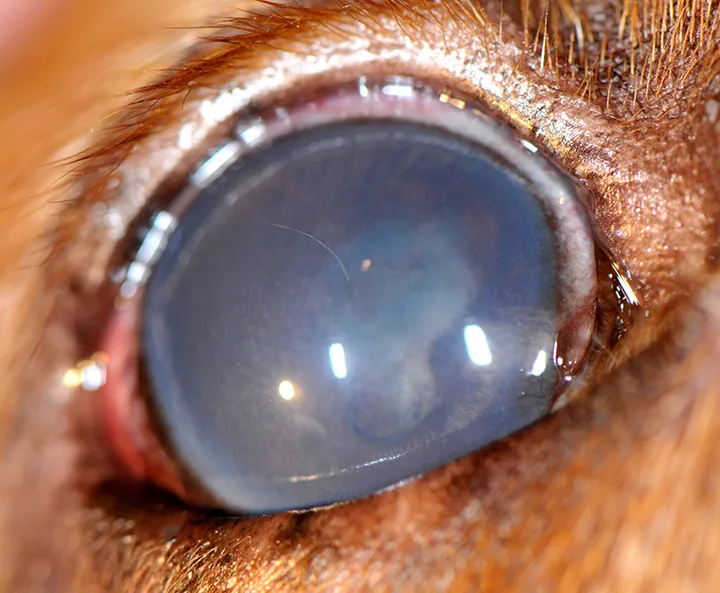This response is incorrect. See below for the correct answer.
Current Understanding of Golden Retriever Pigmentary Uveitis
Elizabeth A. Giuliano, DVM, MS, DACVO, University of Missouri
In the Literature
Jost HE, Townsend WM, Moore GE, Liang S. Golden retriever pigmentary uveitis: vision loss, risk factors for glaucoma, and effect of treatment on disease progression. Vet Ophthalmol. 2020;23(6):1001-1008.
The Research …
Golden retriever pigmentary uveitis (GRPU) has unique ocular features, and because of its relatively high prevalence (10%-18%) in older golden retrievers, it is suspected to be an inheritable trait in this breed.1,2 The hallmark clinical features include pigment deposition on the anterior aspect of the lens capsule (often in a radial pattern), fibrinous type material in the anterior chamber, posterior synechia, pigment on the corneal endothelium and iris, and uveal cysts. GRPU typically affects both eyes and results in vision loss in ≈50% of affected eyes within a year of initial diagnosis (Figure).3
In this study, serial examinations were performed on 29 golden retrievers (58 eyes) with pigmentary uveitis to determine the proportion of dogs with GRPU that developed vision loss, risk factors for development of glaucoma, and effect of treatment on disease progression. Dogs had to have a diagnosis of GRPU—defined by the presence of radial pigment on the anterior lens capsule—in at least one eye and a minimum 6-month lapse between examinations to be included in the study.
Vision loss in 7 of 9 (77.8%) eyes was secondary to glaucoma, and posterior synechiae and fibrinous material in the anterior chamber were significant risk factors for glaucoma. There was no significant difference in disease progression in patients treated with topical steroids or NSAIDs. The authors concluded that GRPU is a slowly progressive disease with a guarded long-term prognosis for vision and patient comfort.

An 8-year-old, spayed golden retriever with end-stage GRPU in the right eye; pain was present and there was no vision in this eye. Episcleral hyperemia, moderate diffuse corneal edema due to secondary glaucoma (intraocular pressure, 45 mm Hg), posterior synechia, and early cataract development can be seen.
… The Takeaways
Key pearls to put into practice:
GRPU can be devastating in golden retrievers because it can result in vision loss of ≈50% of affected eyes within a year of initial diagnosis and is likely heritable. It is recommended that owners/breeders of golden retrievers establish a good working relationship with a board-certified veterinary ophthalmologist to help manage the course of disease and receive appropriate breeding advice.
The presence of uveal cysts alone is not pathognomonic for GRPU and thus should not be overinterpreted.
Although this study found no evidence that a topical anti-inflammatory drop slows the course of GRPU, the number of study participants was small. However, many ophthalmologists use these drugs in GRPU patients. Regular follow-up examination (eg, every 4-6 months) with applanation or rebound tonometry is critical for appropriate administration of antiglaucoma medication to help preserve patient vision and ocular comfort for as long as possible.